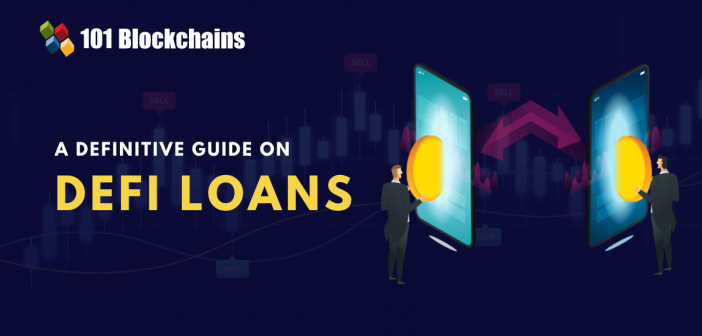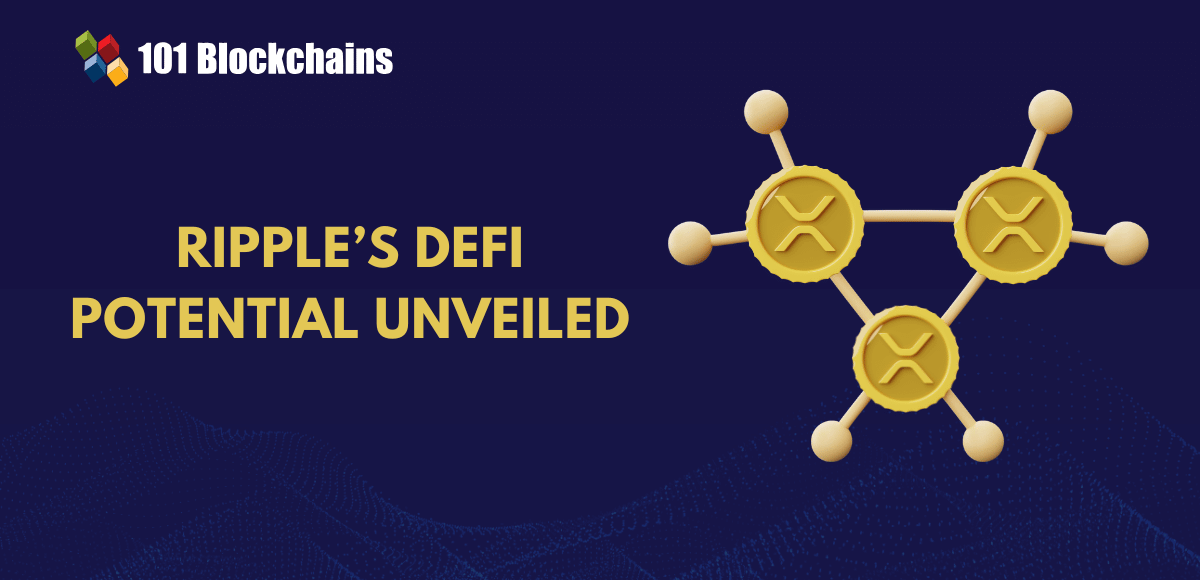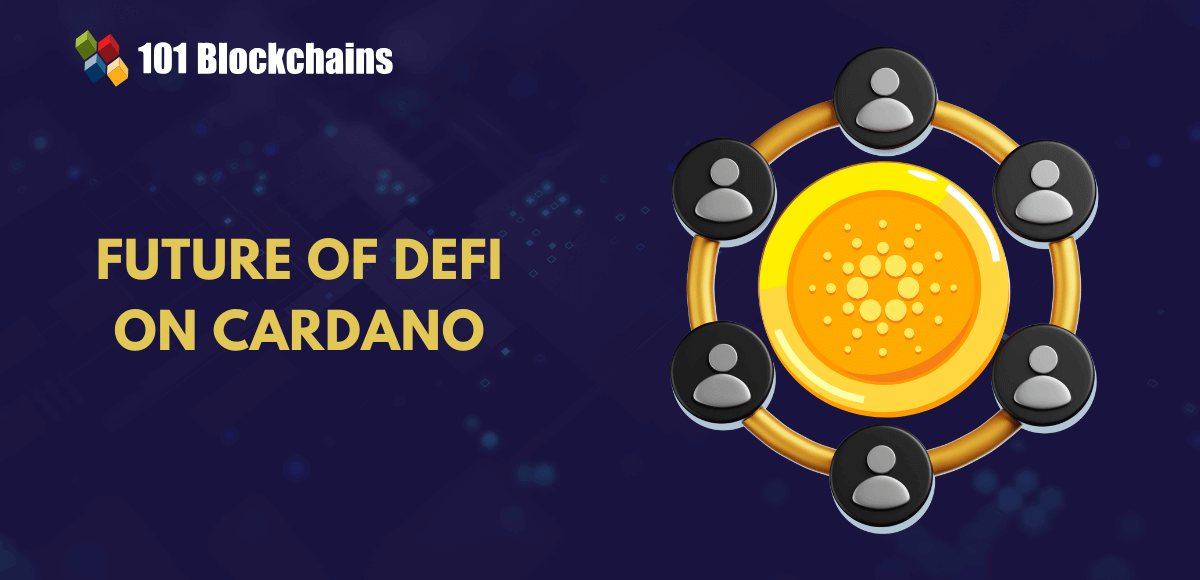Learn how blockchain truly works, master key definitions, and uncover what makes smart contracts so "smart." Dive into the fundamentals, gain valuable insights, and start your blockchain journey today!

- Decentralized Finance
Diego Geroni
- on November 11, 2021
Everything you need to know About DeFi Loans
New to the term DeFi Loans? Here, in this discussion, you will find everything you should know about DeFi loans.
The intriguing potential of blockchain has been a prominent topic of attention for enterprises all over the world. Most notably, the financial sector has been a frontrunner in tapping into the power of blockchain for its advantage. Blockchain has played a crucial role in transforming different financial services ranging from cryptocurrency trading and storage to online payments.
Now, the rise of DeFi has strengthened the prospects for the implementation of blockchain in the development of fintech applications such as DeFi loans. Decentralized Finance or DeFi has been gaining prominent levels of attention in recent times while garnering massive amounts of capital.
With almost $20.46 billion locked in DeFi protocols, the popularity of DeFi applications has definitely escalated by considerable margins. Decentralized finance loans have taken center stage among other DeFi applications with many popular platforms such as Compound, Aave, and Maker. Let us take a deep dive into DeFi lending in the following discussion.
Want to know what is the scope and purpose of DeFi? Enroll Now in Introduction to DeFi – Decentralized Finance Course
Understanding DeFi
The foremost prospect associated with blockchain and cryptocurrencies points towards accessibility of financial services to anyone. Just like the traditional banks, crypto assets could provide similar financial services in a decentralized manner. Some of the common financial services referred to in this case include lending, margin trading, sports trading, and borrowing. In the basic sense, DeFi basically refers to the ecosystem of financial services built on the foundation of blockchain technology.
DeFi offers freedom from intervention of third-party intermediaries in access to financial services. Any account of DeFi loans explained properly would show you how DeFi aims at offering a transparent, permissionless, and open-source financial services ecosystem. It is also important to note that smart contracts serve as the foundation for DeFi due to their self-executing nature. Ethereum has been the frontrunner of the DeFi concept, and as a result, majority of DeFi applications are developed on top of Ethereum.
Want to explore in-depth about DeFi protocol and its use cases? Enroll In Decentralized Finance (Defi) Course- Intermediate Level Now!
What are DeFi Loans?
The first thing you would need to learn about decentralized finance loans is the definition of DeFi lending. The decentralized finance lending platforms basically focus on offering crypto loans with a trustless approach. According to the trustless approach, users could lock their crypto assets on the lending platforms without worrying about any intermediaries. Borrowers can take DeFi loans directly from the decentralized platform through P2P lending.
In addition, the DeFi lending protocol also helps the lender in earning interest on the crypto assets they have locked in the protocol. Interestingly, DeFi lending protocols have shown formidable levels of growth in comparison to other decentralized applications. Furthermore, DeFi lending is also responsible as a major contributor in locking crypto assets.
Want to understand the best ways to use DeFi development tools like Solidity, React, and Hardhat? Enroll now in DeFi Development Course!
Differences between DeFi Lending and Traditional Lending
DeFi lending relies on the power of blockchain technology and leverages all of its exceptional features for improving performance in comparison to traditional lending. DeFi loans offer the assurance of complete transparency alongside streamlining access to assets with each transaction without the involvement of intermediaries. DeFi lending presents a simple and easy-to-understand borrowing process. Borrowers have to create their accounts with the DeFi platform and have a crypto wallet. With a censorship-free environment, DeFi ensures immutability without any preferential treatment.
DeFi lending provides exceptional benefits for lenders as well as borrowers. The facility of margin trading options could help long-term investors in lending assets for earning higher interest rates. In addition, it also helps users in accessing fiat currency credit for borrowing loans at lower interest rates in comparison to decentralized exchanges. Furthermore, users can sell fiat currency on centralized exchange for cryptocurrency, which they could lend on DEXs.
Want to explore an in-depth understanding of security threats in DeFi projects? Enroll in DeFi Security Fundamentals Course Now!
Working of DeFi Lending
The next important aspect to understand the best DeFi loans effectively would point towards the working of DeFi lending. One of the crucial aspects of crypto assets would refer to their continuously fluctuating values. However, your crypto-assets do not build up any interest when they are resting in your wallets. So, you couldn’t procure any earnings by letting your cryptocurrency sit idly in your crypto wallets. In this case, you would have to turn towards decentralized finance loans or DeFi lending.
DeFi lending helps users in lending their crypto to another individual and earning interest on the amount they have loaned. Conventionally, banks have been the go-to destinations for any type of loan. If you needed a loan, you had to go to the bank. However, the rise of DeFi has enabled any individual to become a lender, just like a bank. You can loan your assets to others and accrue interest on the loan.
Just like the loan offices in traditional banks, DeFi loans rely on lending pools. Users could add their assets to the lending pools and ensure their distribution among borrowers by leveraging smart contracts. With the different types of mechanisms for the allocation of interest to investors, it is important for lenders to identify the interest type. Borrowers also need to carry due research on lending pools, with each pool having different approaches for borrowing.
The Collateral in DeFi Lending
The most crucial aspect in the working of DeFi loans explained properly is the question about collateral for DeFi lending. When you want to take a loan from the bank, you need to deposit some form of collateral. The collateral is basically a security deposit, which the bank can claim if you fail to repay the loan. For example, if you have borrowed a car loan, the car serves as the collateral. The bank could seize the vehicle if you fail to pay back the loan in time. You may have assumed that DeFi loans would not have any collateral as they are different from traditional bank loans.
DeFi lending also follows the concept of collateral, albeit with stark differences from the traditional bank loans. First of all, DeFi lending is anonymous, and the next interesting thing is that a decentralized system does not use any type of physical property as collateral. In the case of a decentralized system, borrowers must offer collateral that is more valuable than the amount borrowed. Smart contracts help in depositing the collateral for decentralized finance loans, which must be similar, at least to the value of the loan you want to borrow.
You can discover different variants of collaterals in the case of DeFi lending, and any crypto token can help you exchange borrowed cryptocurrency. For instance, if you want to borrow a Bitcoin, you must deposit at least the price of one Bitcoin in terms of DAI. In addition, the continuous fluctuation in the value of Bitcoin also creates concerns about the cost of collateral dropping below the price of the loan. So, what can you do in such cases?
Want to know about the current trade finance processes and how blockchain can improve them? Enroll Now: Enterprise Blockchains and Trade Finance Course
Example of Collateral Issues in DeFi Lending
Let us assume that a user wants to borrow a loan of 100 DAI. It is important to note that MakerDAO requires collateral of at least 150% of the value of the loan. So, it clearly means that the borrower must provide collateral of $150 in ETH for the loan. If the value of the collateral drops below $150 ETH, then it results in a liquidation penalty.
Advantages of DeFi Lending for Users
The benefits of DeFi lending are also another crucial aspect in understanding the value it brings for users. Here are some of the notable ways in which the best DeFi loans help general users.
-
Improved Speed for Loan Approval
The digital advantage associated with DeFi loans presents the opportunity for faster processing speed. DeFi lending protocols have the support of cloud-based services, machine learning algorithms, and analytics for fraud detection.
-
Better Consistency in Decisions
DeFi lending introduces consistency in the lending decisions with clearly outlined rules for credit policies.
-
Permissionless
Decentralized finance loans offer open and permissionless access, thereby enabling any individual with a crypto wallet to access DeFi applications. Furthermore, people could borrow loans with DeFi without any barriers of geographical location or minimum amount of required funds.
-
Programmability
DeFi also offers the prospects for high programmability with smart contracts, which could enable automated execution. In addition, it can also introduce better prospects for developing new digital financial instruments and assets.
-
Self-custody
Another important value advantage associated with DeFi loans points towards the opportunities for users to gain control over their assets. With the help of Web3 wallets such as Metamask, DeFi users could maintain formidable control over their assets.
-
Immutability
The next crucial advantage of DeFi lending points towards the immutability of the blockchain. The decentralized architecture of blockchain ensures data coordination without any concerns of tampering. As a result, you can be sure of auditability and higher security in the case of decentralized finance loans.
-
Interoperability
The final and most critical advantage with DeFi lending protocols refers to interoperability. Therefore, the different DeFi protocols could easily integrate with each other for offering supporting functionalities. Interoperability plays a crucial role in DeFi lending as you can lock in one type of crypto to obtain loans in another type of cryptocurrency.
Want to kickstart your career in DeFi? Read here for a detailed guide on How To Kickstart Career In DeFi now!
Risks in DeFi Lending
With a clear impression of DeFi lending basics, you could understand how beneficial it could be. However, DeFi loans are not as straightforward as you imagine them to be. You could find some prominent risks associated with DeFi lending, which can influence the ways in which you use it. First of all, you need to note that DeFi lending protocols are safe and offer considerable levels of security.
However, hackers have been successful in exploiting the vulnerabilities in DeFi protocols for stealing the assets of users. For instance, a popular DeFi protocol, Value, made highlights for a complex attack that compromised DAI stablecoins on the platform estimated at a value of almost $8 million. Furthermore, another DeFi protocol, Akropolis, also experienced losses of $2 million in an attack with a similar approach to Value.
So, it is reasonable to wonder about “Are DeFi loans safe?” when you notice such humongous attacks on DeFi protocols. As a matter of fact, the security of funds in the DeFi protocols depends on the security of the code underlying the protocols. In addition, the risks of market movements are also responsible for the under-collateralization of users. As a result, users might have to add more funds as collateral for avoiding liquidation.
Borrowers should also note the concerns of over-collateralization of their loans, like in the case of MakerDAO. Many borrowers deposit around 200% more than the amount of loan they want to borrow. When the price of the collateral asset starts falling, the pool will employ a circuit breaker. The pool could not lose money at any cost, and it could liquidate the collateral for covering the loan when the price of the collateral asset falls below 120% of the loan amount. Ultimately, the borrower would have the loan amount and would lose the collateral asset.
Want to learn the basic and advanced concepts of stablecoins? Enroll Now: Stablecoin Fundamentals Masterclass
Top DeFi Lending Platforms
Any discussion on DeFi loans explained in detail would also include an outline of the best DeFi lending providers. The DeFi lending marketplace has witnessed the rise of many new innovative platforms, which can drive massive breakthroughs in the world of cryptocurrency and financial services. Here is an outline of some of the top DeFi lending platforms you can find today.
-
Compound

The compound is one of the best DeFi loans application, which leverages a money market approach for borrowing and lending applications. It leverages different pools of capital for all the supported cryptocurrencies. Lenders could deposit a specific amount of crypto in lending pools and earn interest without any fixed loan duration. The compound has also brought a new governance system recently for introducing community governance. As a result, it can now enable users to suggest, debating and implement suggestions and new developments.
-
Aave

The next top entry among best DeFi loans protocols is Aave. The decentralized liquidity market platform is non-custodial in nature, and users could participate in the protocol as borrowers or depositors. Depositors play a crucial role in driving liquidity in the market for earning a passive income on the asset. On the other hand, borrowers could procure loans in under-collateralized or over-collateralized manners.
Users seeking to use the Aave protocol must deposit the selected asset and a specific amount. Within a short period of time, lenders could start earning passive income according to the market borrowing demand. Furthermore, depositing their assets enables users to borrow loans against their deposited assets. The interest earned on the deposited funds could help in offsetting the interest rates accrued by users through DeFi loans.
-
Alchemix

Another prominent example of a DeFi lending platform, Alchemix, serves as a DeFi platform for loans with a unique twist. Alchemix offers loans that can repay on their own. Users have to deposit DAI into smart contracts for borrowing decentralized finance loans on Alchemix. Subsequently, users can receive tokens that serve as representatives of the future yield farming potential of the deposit.
Alchemix uses the aIUSD token, which you can transmute into DAI in the Alchemix platform. Then you can trade them on a specific DeFi exchange according to your convenience. The Alchemix DeFi lending platform aims to transform conventional perspectives on the potential of DeFi. It offers considerably higher and flexible instant loans with the synthetic protocol token, aIUSD, having the support of future yield.
-
Maker

Maker of MakerDAO is undoubtedly another notable addition among the platforms to fetch the best DeFi loans. It is highly popular as a decentralized governance platform powered by DAI, which has the target price at $1, thereby qualifying as a stablecoin. Interestingly, MakerDAO features a decentralized governance community that takes care of managing the creation of DAI. It enables the development of DAI by leveraging the embedded governance mechanism you could find in the Maker protocol.
The Maker DeFi protocol features a collection of smart contracts tailored for reducing the price volatility in DAI stablecoin. As a result, it can help lenders and borrowers by removing the concerns of counterparty risk. The unique highlight of MakerDAO is the fact that it is the first DeFi protocol to gain significant levels of adoption. As of now, Maker continues to be one of the biggest dApps on Ethereum.
Want to know the core concepts of blockchain technology and its ecosystem? Enroll Now: Certified Enterprise Blockchain Professional (CEBP)
Bottom Line
The promising growth of DeFi in 2020 has definitely paved the road for driving the future of DeFi lending protocols. However, the future of DeFi loans would definitely bring many opportunities and, at the same time, introduce some new challenges. The majority of DeFi-based projects are garnering the attention of investors, enterprises, and the general public for their advanced technical perfection. DeFi lending protocols introduce freedom from traditional intermediaries in financial services of borrowing and lending.
Most important of all, they offer an interesting avenue for crypto holders to earn passive income or interest on their holdings. Honestly, there is no point in letting your crypto assets sit idly in your wallets. On the other hand, it is also important to ask, “Are DeFi loans safe?” with so many hacking attacks on DeFi lending platforms in recent years. At the same time, the rise of many new DeFi lending platforms such as Compound and MakerDAO point towards favorable prospects for DeFi lending in the future. Learn more about DeFi lending and how it can transform financial services altogether to understand its true potential.
*Disclaimer: The article should not be taken as, and is not intended to provide any investment advice. Claims made in this article do not constitute investment advice and should not be taken as such. 101 Blockchains shall not be responsible for any loss sustained by any person who relies on this article. Do your own research!



![30+ Best Decentralized Finance Applications [Updated] best decentralized finance (DeFi) applications](https://101blockchains.com/wp-content/uploads/2020/10/decentralized-finance-applications.png)

